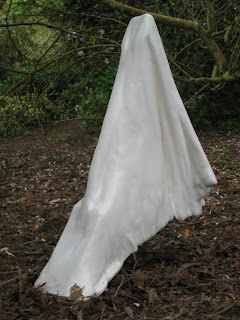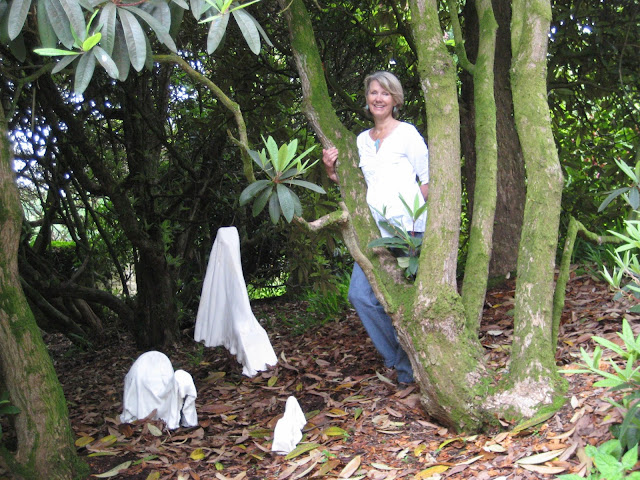Friday, 21 June 2013
Commission from the National Trust at Trelissick Gardens, Cornwall
 |
Spirit of the Garden
9 May - 9 June 2013
|
Trelissick garden is situated in an area of outstanding natural beauty, a gently folding landscape containing oaks, beach, exotics and rare specimens, and leading down to the River Fal. This assignment was to produce installations that were sympathetic to the surroundings and appropriate for National Trust visitors.
When researching the property, the list of dedicated gardeners reminded me of my own dedicated and gentle gardener Jack from years ago, who died of cancer. My work is an hommage to gardeners, especially Jack.
Process
Old garden tools were chosen to become spirits of garden tools. The tools had to be staked into the ground so had metal rods welded to them, before being covered in hessian fabric dipped in Keramicast plaster. |
| An old spade was covered in cling film to prevent the rust from dis-colouring the plaster. |
 |
| Wet hessian was cut to size over the spade after metal rods had been welded to it, to go into the ground. |
 |
| The hessian was then dipped in plaster and was very heavy so needed two people to put in place. |
 |
| Help from a first year student was much appreciated! |
 |
| Extra layers of plaster were gradually added all over. |
 |
| As the plaster is hardening drips form, which need to be removed. |
 |
| Whilst wet the form was very heavy and difficult to balance at the right angle for the folds in material to fall at the required angle. |
 |
| A lot of sanding was needed to re-find the folds in the fabric. |
 |
| The final piece awaiting installation. |
 |
| The same treatment was given to a watering can |
 |
| And also to a garden trowel.
This tool has been likened to the appearance of a coffin.
|
Final Installation
 |

Artist Statement
Spirit
of the Garden
“The act
of ‘gardening’, as well as the activities enjoyed in the garden, contributes to
a sense of well-being. Gardening is
dependent not only on the input of the human being but also on the part played
by nature.”
Cooper,
David E. 2008. A philosophy of Gardens.
In
memory of my gentle, dedicated gardener, Jack.
Raku Firing and Hot Glass at Port Elliot, Cornwall
 |
| Kiln used for raku firing |
 |
| Glazed pots ready for firing |
 |
| Pots inside the kiln |
 |
| Detailed surface texture achieved |
 |
| Resulting Raku fired pot made of crank clay |
The glass blowing was enjoyed by some, using a mixture of reclaimed bottles, melted down in the glory hole, producing a slightly blue tinted glass, which turned darker blue as the quantity of glass in the glory hole lessened. It was presumed that the blue colour sunk to the bottom.
Moulton glass was also poured into sand moulds, but these pieces did not spend enough time annealing (cooling down under controlled heat) so all smashed before being cold.
 |
| Raku kiln with glory hole behind for hot glass |
 |
| Plymouth University Student Glass blowing |
 |
| Glass cast in sand |
 |
| Paper kiln alight |
 |
| John Grayson of Plymouth University and students watching the paper kiln float out to sea |
Thursday, 31 January 2013
Entrapment
Often influenced and inspired by feelings from
deep within, this piece is inspired by
emotions of despair, submission, control, manipulation and loss of freedom.
Cast or slumped glass
is delicate, fragile and pure, and allows a form to be seen through its clear
body, reflecting light, like the spirit within.
Metal, especially when rusted, has a more
masculine appearance, strong, aggressive.
The use of thorns, made of cast metal, add an intimidating aspect.
Subscribe to:
Comments (Atom)






